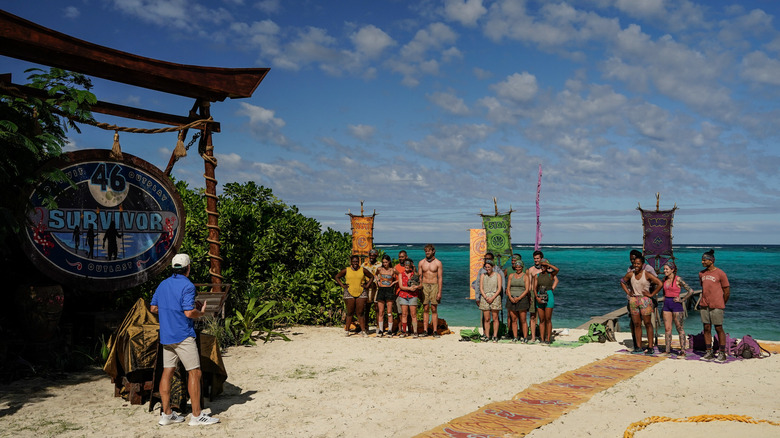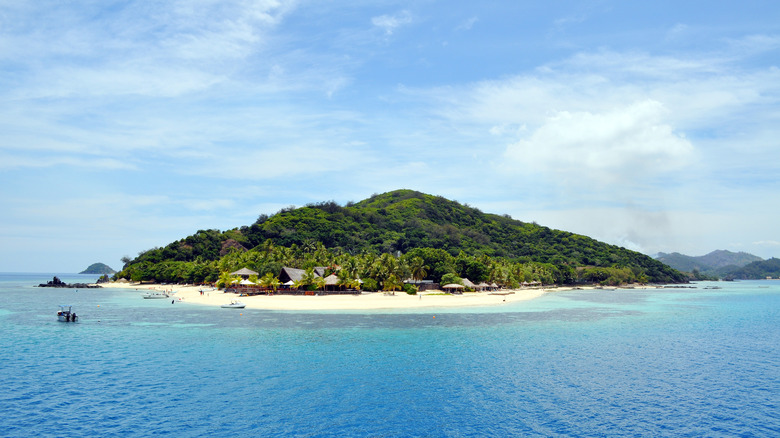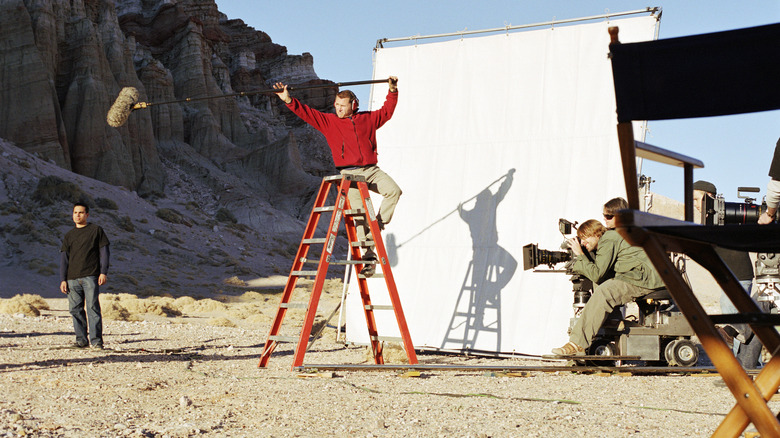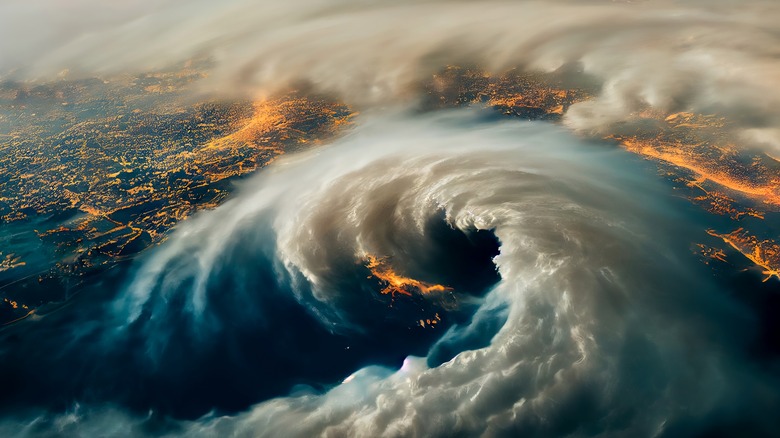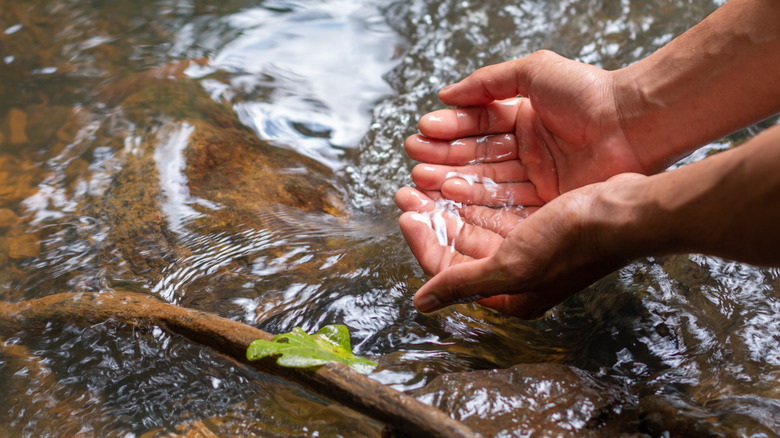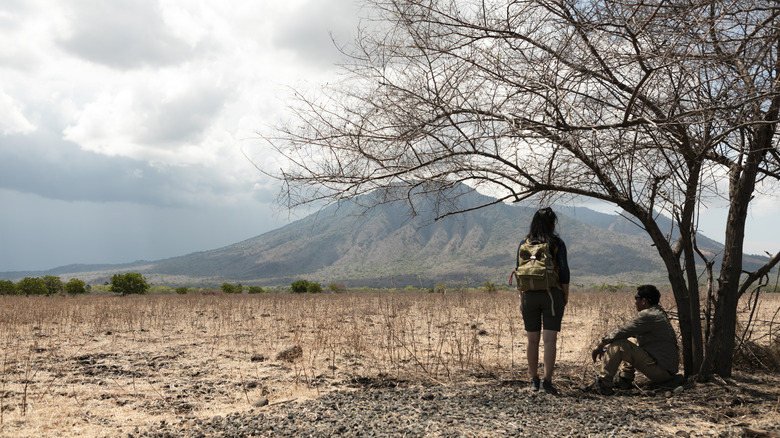All The Ways Climate Change Is Taking A Toll On Survivor
"Survivor," the iconic reality TV series known for its grueling challenges and strategic gameplay, has long captivated audiences with its tales of endurance. In this heart-pounding world, contestants battle each other in a quest for victory — for survival. Yet, over the course of its remarkable 45 seasons, now airing its 46th, as of this contestants have been forced to navigate an increasingly intricate terrain, molded not only by strategic play between competitors but also by the unyielding impact of climate change.
As climate change continues to exert its influence on the planet, "Survivor" finds itself grappling with a new set of challenges as each season passes. What once might have been seen as mere entertainment is now an unintentional reflection of the very real struggles faced by communities around the globe. As the show's contestants, crew, and executives confront these challenges head-on, they are met with scorching heatwaves, torrential downpours, and everything in between. The elements themselves have become formidable opponents, testing not only the limits of human endurance but also the production's ingenuity. Read on to discover all the ways climate change is taking a toll on this enduring show.
Changing geography has limited shooting locations
For nearly two-thirds of its run, "Survivor" captivated audiences by whisking them away to diverse and exotic locations each season. Remember early seasons like Vanuatu in Season 9 or the Amazonas in Season 6? From lush jungles to beachy shores, the show's ever-changing backdrop added an element of adventure and intrigue. The allure of these untouched natural environments was integral to the show's premise.
However, the show's ability to film in various locations has dwindled as many areas become increasingly vulnerable to the effects of climate change. Rising sea levels and coastal erosion driven by warming global temperatures have disrupted this dynamic. This environmental transformation has significantly reduced the once vast array of potential filming locations, posing new challenges for the production team.
In response to these challenges, "Survivor" producers have had to adapt their approach. Since Season 33, the show has been exclusively filmed in the Mamanuca Islands of Fiji. While Fiji offers stunning landscapes and diverse terrain, the decision to settle on a more permanent location reflects the necessity for stability and safety in filming locations amidst the changing climate.
The crew needs to be innovative
A shift towards a fixed setting raises legitimate concerns regarding the show's long-term appeal to viewers. Without the draw of exploring new, exotic locales each season, some may fear that "Survivor" could lose its freshness and audience engagement over time. However, the production team behind "Survivor" has embraced innovation and creativity, ensuring that the show remains dynamic and engaging.
The show's executives are quick to reassure fans that while the novelty of changing locations may have diminished, the introduction of thematic seasons like "David vs. Goliath" or "Winners at War" injects a renewed sense of excitement and unpredictability into the gameplay, ensuring that each season remains captivating and distinct despite the stagnant setting.
By acknowledging and adapting to the realities of a changing climate, producers have found opportunities to explore new storytelling avenues that resonate with audiences on a deeper level. Through its ability to adapt and innovate, the show reflects the complexities of the modern world, delivering thrilling gameplay and compelling narratives that keep viewers eagerly tuning in season after season. This resilience in the face of a changing climate underscores the show's enduring appeal and relevance.
Extreme weather contributes to safety hazards
Beyond limiting shooting locations, climate change has exacerbated extreme weather conditions that pose significant challenges for "Survivor." As climate change intensifies, episodes of extreme heat, torrential rain, and powerful storms have become more frequent and unpredictable, posing new obstacles for those involved in the show. Contestants must navigate the physical and mental demands of the game amidst some of the harshest environmental conditions the planet has seen in decades. In worst-case scenarios, sweltering heatwaves can lead to dehydration, heat exhaustion, and heatstroke.
Behind the scenes, the show relies on a global crew of over 300 individuals to deliver the captivating drama viewers enjoy from their living rooms. These dedicated personnel endure the elements alongside the contestants, both during filming and in preparation. Leading the charge are the show's producers, who venture ahead of filming to scout locations, knowing that effectively managing the logistical hurdles presented by extreme weather is essential for ensuring the safety and success of the show. Filming schedules may require swift adjustments to accommodate adverse weather conditions, and proactive measures are taken to safeguard people, equipment, and infrastructure against potential damage.
Furthermore, the well-being of cast and crew members takes precedence, with established protocols for evacuating filming locations and providing medical assistance as needed. As host and executive producer Jeff Probst told The New York Times, "Storms were more intense, and there was no denying it — we had been out in these waters before and it was never like that," underscoring the logistical hurdles faced in TV production.
Less food and water makes contestants more vulnerable
Food and water scarcity are pressing concerns for contestants on "Survivor," exacerbated by the challenges posed by climate change. Though the occasional reward is thrown in, the castaways must rely on their hunting and scavenging skills for their primary sources of food. Access to clean, potable water is paramount for survival, yet climate change has made this precious resource increasingly scarce. Rising temperatures and shifting precipitation patterns make drought conditions more common, drying up natural water sources and making hydration a constant concern for contestants. Moreover, the encroachment of coastal erosion and saltwater intrusion poses a dual threat by jeopardizing freshwater reserves. This exacerbates the challenge of sourcing safe drinking water, a critical issue heightened by Fiji's oceanic setting.
Likewise, the struggle to obtain food is intensified. In fact, a number of contestants have cited a shortage of food and water as one of their reasons for quitting the show. Warmer waters and altered marine habitats can disrupt fish populations, making fishing and foraging more difficult in island settings. Additionally, extreme weather events such as storms and floods can damage vegetation and disrupt food sources, further exacerbating food insecurity for contestants.
Shelter is harder to find and build
Finding shelter is a crucial aspect of survival for contestants on "Survivor." The show typically takes place in remote and exposed locations, where contestants are vulnerable to the elements. With climate change exacerbating weather extremes, the need for sturdy and resilient shelter is more pressing than ever.
Contestants must rely on their ingenuity and resourcefulness to fashion shelters using natural materials found in their surroundings. These makeshift structures often consist of branches, leaves, and other vegetation since the show's contestants are only limited to using what they find. The construction process requires teamwork and strategic planning, as contestants must balance the need for shelter with the limited resources available.
However, climate change poses new challenges to shelter construction. Coastal erosion and rising sea levels may threaten the stability of beachfront shelters, while increased wind speeds and heavy rainfall can test the durability of makeshift structures. Contestants must adapt their building techniques to withstand these environmental pressures, reinforcing shelters and seeking out more sheltered locations when necessary.
